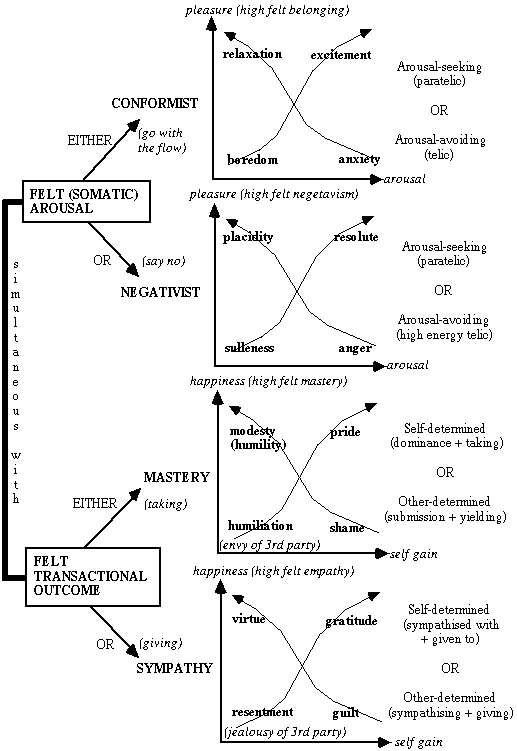The Gamut of Emotions
by Peter Shepherd
Healthy psychological development in childhood, and self-actualisation in adulthood, require the individual to experience motivational reversals on a regular basis, between each of the motivational dichotomies, so that dominance tendencies do not become fixated. In the paratelic mode the individual explores in a relatively open ended and adventurous way, thus becoming familiar with many aspects of his environment, and developing a range of skills. In the telic mode, the effectiveness of these skills and the relevance of this knowledge is then tested out and modified during serious attempts to cope with anxiety-provoking problems.
One of the major causes of developmental failure is for the paratelic mode to occur too infrequently, the effect of which is that the individual does not have a wide enough range of developed skills to draw from, in confronting serious situations. This results in increasing rigidity of behaviour patterns, a few stereotyped avoidance responses tending to be used in the face of threats. Since these forms of response are less likely to be effective than more sophisticated reactions, the individual will tend to feel even more threatened and become entrenched still further in the telic mode - and thus have even fewer opportunities for learning or self-affirmative experiences. A negative learning spiral has been set up, as discussed previously in relation to the COEX. The range of primary emotions resulting from the inter-action of motivational states, is illustrated in the following structural diagram:

The deep structure underlying the generation of 16 primary emotions
(1 of the 8 somatics always accompanying 1 of the 8 transactional emotions)
If parents and teachers provided sufficient emotional support and security, thus encouraging an active paratelic involvement based on a sound first (bio-survival) program, negative learning-spirals (COEXs) would be less likely to develop. Transformational Psychology counselling and training can be seen as breaking into such a spiral by providing an empathic and constructive relationship within which the causes of telic reversals can be viewed and valuable global skills may be practised. In this way, the second (emotional-territorial) and third (semantic) programs are developed, with the further security of a disciplined group ethic supporting a revised fourth (socio-sexual) program. The individual may then stretch his wings in the negativistic mode, breaking away from conformity to the imposed strictures on his life, to attain a healthy sense of identity and to learn the limits of action in different spheres.
One should be able to experience the warm agreeableness of being a good citizen, but also from time to time the keen pleasures of defiance and independence; one should be able to experience the pride of personal strength as well as, on other occasions, the comforts of modest humility. The person who can only be serious, can only conform, and can only be modest, displays a stability which is maladjusted. The person who can never be serious, is always awkward and difficult, and continually strives to dominate others, is equally unhealthy.
(A peculiar fact is that supposedly unpleasant 'negative' emotions - such as anger, horror, greed, contempt, fear, disgust - may be enjoyed, given sufficient protective detachment from the contingent circumstances, such as is provided by the cinema, sports field or TV news. These 'parapathic' emotions exist alongside their telic 'twins' of the same name, but have an inverted relationship to hedonic tone. The moments of horror, grief or tragedy, when we are thrilled or moved, are the 'best' parts of the experience. It seems that whatever the source of arousal and whatever the emotion, it will be enjoyed in the paratelic mode, if it is sufficiently intense and we are protected enough for a reversal to the telic not be caused.)
Move on to Transactions.
Return to Transforming the Mind - Contents.